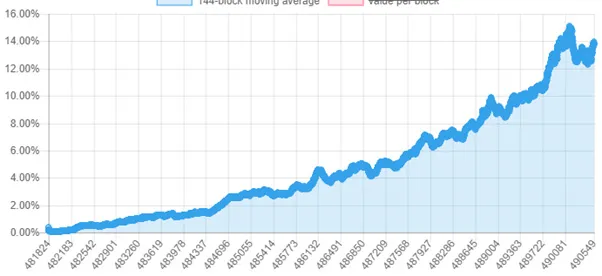|
Getting your Trinity Audio player ready...
|
Segregated witness was for many months, in fact, years, promoted as a scaling solution to Bitcoin. Not just within Segwit Core’s echo chamber, but also among many prominent mainstream news outlets. It is no surprise then, that an overwhelmingly large group of investors looked towards Segwit as a promising solution to liberate Bitcoin of its bottlenecks of congestion.
The fact Segwit was sold as a scaling solution cannot be overlooked, as evidenced in the following links, as examples:
• https://www.forbes.com/sites/ktorpey/2017/08/31/this-solution-to-bitcoins-scaling-drama-has-been-available-for-over-two-years/#36eac25b8673
• https://bravenewcoin.com/news/bitcoin-scaling-solution-segwit-released/
• https://holytransaction.com/blog/2016/10/bitcoin-segwit-scaling-solution.html
Now, we are almost 3 months in from the moment of Segwit activation. Approximately 13% of Segwit1x transactions are Segwit based, and the effective average blocksize has grown from 1MB to 1.02MB (as seen on dates 13th and 14th of October).
So what have we really been given?

Due to the nature of the soft-fork, Segwit transactions accumulate in count up over time, as evidenced in the above graph. This is to ensure, backward compatibility with the standard Bitcoin protocol. This enables both Bitcoin and Segwit transactions to co-exist side by side, until Segwit transactions consume and become the majority of transactions. How long it takes to reach 100% will certainly be interesting to watch and take note of. But one thing for certain is that it will take a drawn-out time. At present the count is accelerating.

The return on investment so far, given the average of 1.02MB effective blocksize seems shockingly small. But supposing we get to a point where everyone is using Segwit, and miners are mining maximum size blocks, what do we get to? Calculations have already been made by many in the industry, that predict a 1.4-1.6 times capacity increase. For argument sake though, let’s assume the Segwit Core narrative… Ciphrex CEO and Segwit Core spokesman, Eric Lombrozo stated that uses can expect a capacity increase of 1.8 times.
In what world does this sort of increase, for such a wildly publicized upgrade, provide global scale. The short answer, it doesn’t.
In fact, Segwit is actually anti-scaling. Allow me to elaborate.
The truth is a simple 2MB hardfork would have provided far more capacity, than Lombrozo’s stated 1.8 times increase for Segwit. An often unmentioned fact of Segwit is that it comes with a heavy Blockweight. In fact, at 4MB, we can expect to get 1.6 at most (or 1.8 if you take Lomborozo’s number) times as an increase. 4 times the size, for a generous 1.8 times return on investment, is anti-scaling.
The narrative from the small block camp is that now we look to 2nd layer solutions, and we are back to the original cat and mouse game of moving goal posts. LN has its own scalability solutions at present… Second layer solutions may very well come, but it does not explain the militant, resolute stance on this artificial cap. Nor does it explain the fact that Segwit itself was sold as a scalability solution as referenced above.
Segwit provides a malleability ‘fix’, and this is in fact the prime reason for the political push on Segwit. But Malleability is not necessarily a bug. Segwit’s malleability ‘fix’ provides Blockstream with a solid foundation to deploy their patented off-chain solutions. But perhaps it would’ve been better for everyone if the honesty on this was put forward, up-front.
No matter which we we try to spin this, Segwit in itself, is not a scaling solution for Bitcoin. To explain the return on investment (4MB = 1.6M capacity increase), it is akin to converting a single lane highway, into 4 lanes, but not allowing drivers to use the spare two lanes. Ofcourse, the extra lanes are reserved for witness data. Segwit was sold on a false pretence.
For Bitcoin to attain global success – it needs significant scalability. The rhetoric of “let’s cramp the first layer, but build the second layer” is illogic at its best. One should not be at the expense of the other.
Eli Afram
@justicemate

 09-07-2025
09-07-2025 





